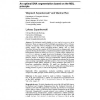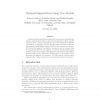31 search results - page 1 / 7 » An Optimal DNA Segmentation Based on the MDL Principle |
CSB
2003
IEEE
13 years 10 months ago
2003
IEEE
: The biological world is highly stochastic and inhomogeneous in its behaviour. There are regions in DNA with high concentration of G or C bases; stretches of sequences with an abu...
ICDM
2006
IEEE
13 years 11 months ago
2006
IEEE
Sequence data are abundant in application areas such as computational biology, environmental sciences, and telecommunications. Many real-life sequences have a strong segmental str...
CORR
2002
Springer
13 years 4 months ago
2002
Springer
We present two methods for unsupervised segmentation of words into morphemelike units. The model utilized is especially suited for languages with a rich morphology, such as Finnis...
ICCV
2011
IEEE
12 years 4 months ago
2011
IEEE
We propose a novel patch-based image representation that is useful because it (1) inherently detects regions with repetitive structure at multiple scales and (2) yields a paramete...
ACCV
2009
Springer
13 years 11 months ago
2009
Springer
We present a novel algorithm for unsupervised segmentation of natural images that harnesses the principle of minimum description length (MDL). Our method is based on observations ...


